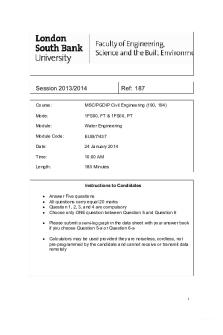Exam 2014, questions and answers PDF

| Title | Exam 2014, questions and answers |
|---|---|
| Course | Organic chemistry |
| Institution | University of Salford |
| Pages | 4 |
| File Size | 173.2 KB |
| File Type | |
| Total Downloads | 42 |
| Total Views | 159 |
Summary
Drug synthesis...
Description
Exam paper –Drug Synthesis 2014 Section A (answer all parts) A1. a. Define the following terms: i. Protecting group A group attached, temporarily, to a molecule in order to remove the reactivity of a functional group ii. Resolution (in single enantiomer synthesis) Separation of a racemic mixture into two enantiomers iii. Convergent synthesis A synthesis in which two different routes are followed to form advanced intermediates which are brought together late iv. Chiral pool Use of an available, homochiral natural product as a starting material for sungle enantiomer suynthesis v. Synthetic equivalent reagent or combination of reagents giving the reactivity suggested by a synthon (2 marks each) b. Write synthons and synthetic equivalents for the following disconnections: O
O
CH 3
O
CH3 Met O
O
O
OH
OH
O
CH 3 Met
CH 3
OH
O
O
Br
+ base
OH
O
OH Met
(4 marks each) c. Draw the forward synthesis corresponding to the following retrosynthetic analysis.
O O
O
N Br
O O
O N O
O O
O
O
OH
O
fgi
O
I
fgi + base
O
OH
O
O
O
8 marks for reversing the retrosynthesis correctly with no synthons left in or other retrosynthesis terminology/arrows. 2 marks each for fgi reagents. (14 marks)
Section B (answer 2 questions) 1.
Use retrosynthetic analysis to design a synthesis of the compound shown below. Write the forward synthesis corresponding to your analysis (credit will be given for correct use of retrosynthetic analysis even if a viable synthesis is not designed). Cl H N
1
For B1, 2 and 3 the same scheme is used: a synthesis, designed using retrosynthetic analysis and likely to work gets 30 marks; a synthesis which would not work but reaches the target using good retrosynthesis technique will get 24-29 marks; a partial synthesis will get a maximum of 5 marks for each step presented with the correct synthons, synthetic equivalents and appropriate forward synthesis, max 4 marks for an fgi. (30 marks) 2.
N H
fgi
Use retrosynthetic analysis to design a synthesis of the compound shown below. Write the forward synthesis corresponding to your analysis (credit will be given for correct use of retrosynthetic analysis even if a viable synthesis is not designed).
O
O HO
2
(30 marks) 3. Use retrosynthetic analysis to design a synthesis of the compound shown below. Write the forward synthesis corresponding to your analysis (credit will be given for correct use of retrosynthetic analysis even if a viable synthesis is not designed).
O N H OH
3
(30 marks) 4. Consider the synthesis shown below: a. List all of the possible problems with the synthesis if it was performed on a large-scale. b. Suggest improvements to the synthesis which would allow process scale work.
i. LDA, THF -78
Cl2
O O
ii. BnBr
O
Cl
FeCl3
O
O
O
98%
50% i. conc. HNO3 ii. Na/Hg LiAlH4 Cl
Cl
OH HO
NaNO 2 O
OH
H 2O
Cl
90%
O
NH2
O
O
35%
86% column chromatography
DIAD, Ph3 P, THF
OH O Cl
O
99%
DMF, POCl 3 Cl
O
CrO3
O
Cl
O
78%
99%
Cl
product washed with water 3 x before removing solvent on a rotary evaporator
SOCl2 CH2 Cl 2
O Cl
O
40%
A) 16 marks (one each) for spotting problems: Step 1: poor yield, expensive and dangerous solvent, low temperature Step 3: aggressive conditions, column chromatography and mercury waste Step 4: Low yield Step 5: Dangerous reagent Step 6: Triphenylphosphine oxide waste Step 7: Dangerous reagent Step 8: Chromium waste Step 9: Expensive and ecotoxic solvent, washing with water requires vessel to be drained, rotary evaporator unfeasible, low yield Overall: very long synthesis B) Up to 6 marks for simple substitutions eg toluene for THF or sodium borohydride for lithal. Other 8 for changes to synthesis eg starting with 3-chlorophenol. Many possibilities exist.
(16+14 marks)...
Similar Free PDFs

Exam 2014, questions and answers
- 23 Pages

EXAM 2014, questions and answers
- 18 Pages

Exam 2014, questions and answers
- 22 Pages

Exam 2014, questions and answers
- 15 Pages

Exam 2014, questions and answers
- 4 Pages

Exam 2014, questions and answers
- 6 Pages

Exam 2014, questions and answers
- 12 Pages

Exam 2014, questions and answers
- 9 Pages

Exam 2014, questions and answers
- 11 Pages

Exam May 2014, questions and answers
- 12 Pages
Popular Institutions
- Tinajero National High School - Annex
- Politeknik Caltex Riau
- Yokohama City University
- SGT University
- University of Al-Qadisiyah
- Divine Word College of Vigan
- Techniek College Rotterdam
- Universidade de Santiago
- Universiti Teknologi MARA Cawangan Johor Kampus Pasir Gudang
- Poltekkes Kemenkes Yogyakarta
- Baguio City National High School
- Colegio san marcos
- preparatoria uno
- Centro de Bachillerato Tecnológico Industrial y de Servicios No. 107
- Dalian Maritime University
- Quang Trung Secondary School
- Colegio Tecnológico en Informática
- Corporación Regional de Educación Superior
- Grupo CEDVA
- Dar Al Uloom University
- Centro de Estudios Preuniversitarios de la Universidad Nacional de Ingeniería
- 上智大学
- Aakash International School, Nuna Majara
- San Felipe Neri Catholic School
- Kang Chiao International School - New Taipei City
- Misamis Occidental National High School
- Institución Educativa Escuela Normal Juan Ladrilleros
- Kolehiyo ng Pantukan
- Batanes State College
- Instituto Continental
- Sekolah Menengah Kejuruan Kesehatan Kaltara (Tarakan)
- Colegio de La Inmaculada Concepcion - Cebu





